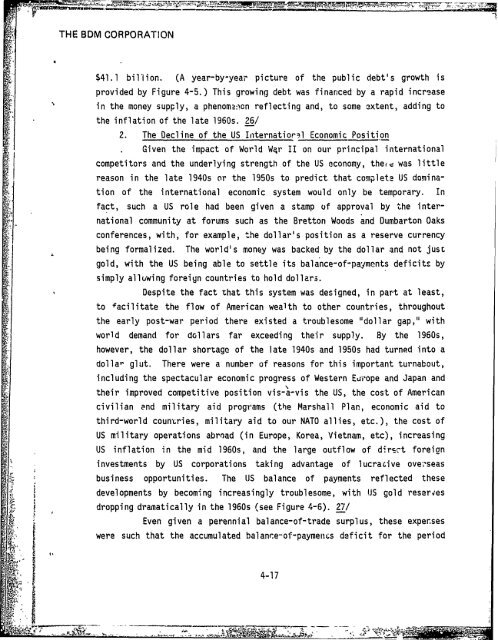policy - The Black Vault
policy - The Black Vault
policy - The Black Vault
You also want an ePaper? Increase the reach of your titles
YUMPU automatically turns print PDFs into web optimized ePapers that Google loves.
THE BDM CORPORATION<br />
$41.1 billion. (A year-by-year picture of the public debt's growth is<br />
provided by Figure 4-5.) This growing debt was financed by a rapid increase<br />
in the money supply, a phenomancn reflecting and, to some 3xtent, adding to<br />
the inflation of the late 1960s. 26/<br />
2. <strong>The</strong> Decline of the US Internatiorql Economic Position<br />
Given the impact of World War II on our principal international<br />
competitors and the underlying strength of the US economy, theod was little<br />
reason in the late 1940s or the 1950s to predict that complete US domination<br />
of the international economic system would only be temporary. In<br />
fact, such a US role had been given a stamp of approval by -the international<br />
community at forums such as the Bretton Woods and Dumbarton Oaks<br />
conferences, with, for example, the dollar's position as a reserve currency<br />
Sbeing formalized.<br />
gold, with the US<br />
<strong>The</strong> world's money was backed by the dollar and not just<br />
being able to settle its balance-of-payments deficits by<br />
simply allowing foreign countries to hold dollars.<br />
Despite the fact that this system was designed, in part at least,<br />
to facilitate the flow of American wealth to other countries, throughout<br />
the early post-war period there existed a troublesome "dollar gap," with<br />
world demand for dollars far exceeding their supply. By the 1960s,<br />
however, the dollar shortage of the late 1940s and 1950s had turned into a<br />
dollar glut.<br />
<strong>The</strong>re were a number of reasons for this important turnabout,<br />
including the spectacular economic progress of Western Europe and Japan and<br />
their improved competitive position vis-a-vis the US,<br />
the cost of American<br />
civilian end military aid programs (the Marshall Plan, economic aid to<br />
third-world countries, military aid to our NATO allies, etc.), the cost of<br />
US military operations abroad (in Europe, Korea, Vietnam, etc), increasing<br />
US inflation in the mid 1960s, and the large outflow of dirsct foreign<br />
investments by US corporations taking advantage of lucrative over-seas<br />
business opportunities. <strong>The</strong> US balance of payments reflected these<br />
developments by becoming increasingly troublesome, with US gold reserves<br />
4 dropping dramatically in the 1960s (see Figure 4-6). 27/<br />
Even given a perennial balance-of-trade surplus, these experses<br />
were such that the accumulated balance -of-paymencs deficit for the period<br />
4-17<br />
i -
















